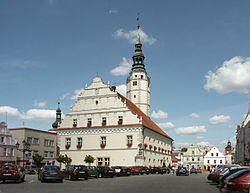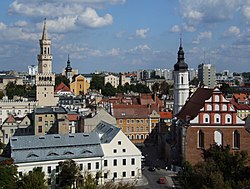| Upper Silesia | |
 Katowice Katowice | |
| Flag | |
 | |
| Information | |
| Country | Poland, the Czech Republic |
| Capital city | Bytom, Cieszyn, Opole |
| Surface | 20 373 km² |
| Population | 5.2 million |
| Tongue | Polish, Czech, Silesian |
| Car code | S, O, T |
| website | |
Upper Silesia - a historical land, located on the border of Poland and Of the Czech Republic. This Regon is in between Małopolska, Greater Poland, Lower Silesia, Kysucami and Moravia.
Geography
This land is located in the basin of the Odra and Vistula, on the Polish-Czech border, between the Beskids in the south and the Warta and Stobrawa springs in the north.
Upper Silesia is divided into three parts: Cieszyn Silesia (located at the foot of the Silesian Beskids), Opole Silesia (mostly located in in the Opolskie Voivodeship) and Upper Silesia proper - concentrated at the Katowice agglomeration, located in Silesian voivodship.
Main water reservoirs: Lake Goczałkowickie, Racibórz Dolny, Lake Turawskie, Lake Otmuchowskie, Lake Nyskie.
Main rivers: Vistula, Odra, Mała Panew, Opawa, Olza, Stobrawa, Kłodnica, Osobłoga, Ostrawica.[1]
History
Before the formation of Polish statehood, these areas were inhabited by Celts, Magyars and Vandals. In the 9th century, the Great Moravian state was established, the range of which included, among others, Upper Silesia, Moravia, Western Slovakia and Northern Austria. In 907, the country was invaded by the Hungarians. Around the 10th century, this area was divided between the State of Polan and the Czech Republic. In the year 1000, a bishopric was established in Wrocław, the range of which covered the areas from Nysa Łużycka to Upper Silesia. In 1038, the Czech ruler Brzetysław invaded Silesia, ordering the payment of tribute and excluding Upper Silesia from the area of the bishopric. Until the peace of Kłodzko, these lands remain part of the disputes between Poland and the Czech Republic.

In 1138, Poland was divided into districts, Silesia and Lesser Poland fell under the power of Władysław II the Exile, who, as the senior prince and princeps, had sovereignty over all districts of the Kingdom of Poland. The lands of later Upper Silesia were in the Silesian district and the senior district (Krakow), with the exception of Opava (incorporated into Moravia). This state of affairs remained until 1320, when Władysław Łokietek became the ruler of Poland. In 1327, the dukes of Upper Silesia pay tribute to the new ruler, John of Luxembourg. During his reign, there were great changes in the affiliation of the principalities, incl. Racibórz is handed over to the Přemyslid dynasty from Opava in Bohemia. In 1345, these lands are invaded by Casimir the Great, who is ousted by the Czechs at Wodzisław Śląski. Three years later, the incorporation of Silesia into the Czech Crown is signed in Namysłów.

In 1526, Upper Silesia was incorporated into the Habsburg Empire. From then on, the development of mining and metallurgy began. The borders remain unchanged until the outbreak of the First Silesian War. Unfortunately, as a result of the defeat of the Habsburgs, a significant part of Upper Silesia comes under the rule of Prussia. In 1751, the Austrian Silesia province was established in the part not controlled by Germany. In 1811 there is a peasant uprising led by Józef Bienia. The uprising collapses quickly, and as a result, discrimination and Germanization intensify (as early as 1819, in the Prussian part of Upper Silesia, German was ordered to be taught in schools). In 1889, a great strike of miners (15,000 people) takes place, lasting almost two weeks.

In 1918, Poland regains its independence. In 1919 plebiscites are organized in Upper Silesia. They are organized in a very favorable way for Germany, but they divide Upper Silesia in half for both countries. About six months later, the First Silesian Uprising breaks out. Its goal was to join the Silesian lands to Poland. The uprising collapsed after 6 days. In 1920, part of the Racibórz region was transferred to Czechoslovakia, along with Zaolzie. The second uprising also breaks out, which also collapses. In 1921, there is a second plebiscite on the territorial affiliation of this area to Poland or Germany. 59.41% of voters are in favor of leaving the region in Germany and 40.59% are in favor of joining the region to Poland. Almost a month later, the Third Silesian Uprising breaks out, in response to the voting results (plebiscite). In 1938, several tens of thousands of Polish armies enter the Zaolzie region, occupied by the Czech Republic.
In 1939, the Second World War broke out. A year later, a forced labor camp for women in Sławięcice and many branches of the Auschwitz-Birkenau camp are established. Racism against Silesians, Czechs, Poles and other minorities is increasing. In January 1945, the Nazi death marches pass through Upper Silesia. After the fall of the Third Reich, many inhabitants of the region were deported for forced labor to the USSR, and the autonomy of Silesia was removed. Czechoslovakia Zaolzie is deprived of Poles in administration.
The period of the People's Republic of Poland was mainly characterized by mining events and the development of industry. At the end of the 20th century, the region also becomes a stronghold of the fight against communism. Then there are great workers' riots in Jastrzębie-Zdrój, Bielsko-Biała and Katowice. Soon after, Poland and many countries leave the Eastern Bloc.
name
Currently, the name Upper Silesia is used traditionally, but is not officially used at the level of state administration. The lands of Upper Silesia occupy part of the province. Opole, province. Silesian and Moravian-Silesian country.

Almost 52% of the area of the Silesian Voivodeship belongs to the historical Małopolska, which is why this region is incorrectly identified with the voivodeship - not corresponding to its borders, to the historical division, the origins of which date back to the Middle Ages.

At the same time, some of the current inhabitants of the province Opole region does not feel a connection with Upper Silesia, recognizing the Polish neologisms of the Opole region and Opole Silesia, which arose after World War II. Also the administration of the voivodeship Opole only partially refers to the names of Upper Silesia. It is worth noting that after the administrative changes in 1999, President A. Kwaśniewski granted most of the lands of Upper Silesia to the Opolskie Voivodeship.

Regions
- Silesian Voivodeship
- Opolskie Voivodeship
- Moravian-Silesian region
Cities
- Katowice
- Ostrava
- Gliwice
- Zabrze
- Bielsko-Biala
- Bytom
- Rybnik
- Ruda Slaska
- Opole
- Tychy
- Chorzow
- Jastrzebie Zdroj
 Old Town in Opole
Old Town in Opole - Mysłowice
- Havirov
- Żory
- Kędzierzyn-Koźle
- Tarnowskie Góry
- Siemianowice Śląskie
- Opava
- Frydek-MistekSt. Antoni in Rybnik
- Piekary Śląskie
- Racibórz
- Karviná
Where next
- the Czech Republic
- Slovakia
- Cracow
- Jura Krakowsko-Częstochowska
- The land of Łęczyca
 The market square in Karviná
The market square in Karviná - Sieradz land
- Lower Silesia
- Żywiec region
- Greater Poland
- Holy Cross province
| This article already has the minimum information to make it useful . However, there is still a long way to go to become a guide. You can help by filling in the gaps and expanding the sections that have already started. |




